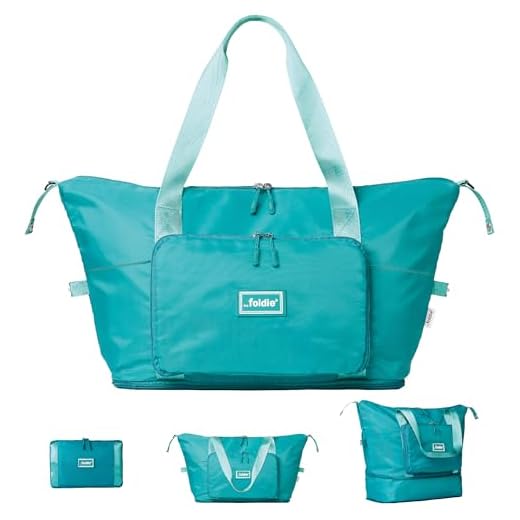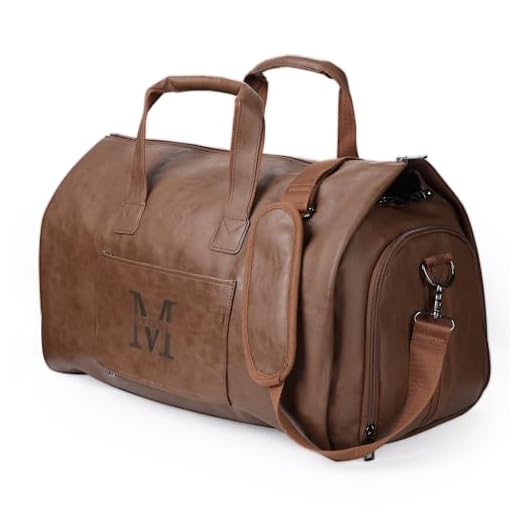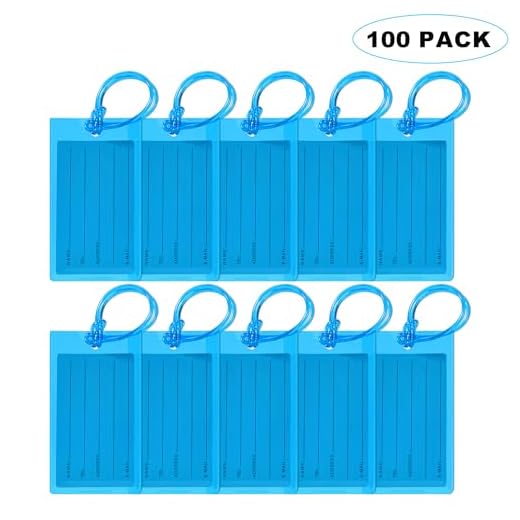







Select a consistent color palette for all your travel bags to create a cohesive look. This approach not only enhances your style but also simplifies identification at the baggage claim area.
Consider investing in personalized accessories, such as unique tags or straps. Adding a monogram or choosing distinct patterns will help your items stand out and reduce the likelihood of mix-ups during travels.
Incorporate matching organizers and pouches inside your carry-on and checked bags. Using a uniform set of packing cubes or pouches will keep everything neat, making it easier to locate your belongings.
For a polished appearance, coordinate the materials and textures of your bags. Pair a leather suitcase with nylon or canvas travel organizers for a sophisticated touch.
Lastly, ensure that the sizes of your bags complement each other. A large checked bag paired with a medium carry-on and a compact personal item offers both utility and aesthetic appeal.
Complementary Pieces Selection
Select items that visually coordinate, focusing on colors and materials. Choose a set featuring the same color palette or complementary tones, such as pairing navy blue with white or earthy tones with pastels. This approach ensures all pieces create a unified appearance.
Consider functionality and size variations. Opt for a primary carry-on that matches a larger suitcase, enabling a cohesive look while accommodating different travel needs. Choose a duffle bag or personal item that aligns with the established theme, either in color or texture.
Examine brand consistency. Many brands offer collections allowing for mixed styles while still appearing intentional. Aim for pieces that share similar design elements like zippers, stitching, or hardware finishes to maintain a polished aesthetic.
Incorporate unique visuals for personalization, such as monograms or personalized tags. Such elements provide individuality while still contributing to the overall design ethos. Avoid overcomplication; simple, consistent patterns create a harmonious blend.
Finally, analyze practicality. Ensure chosen items are functional and align with travel habits, balancing aesthetic appeal with usability. Well-planned selections minimize the risk of mismatches while enhancing travel efficiency.
Selecting the Right Color Scheme for Your Luggage
Choose colors that stand out. Bright shades like red or lime green enhance visibility and make spotting your bags on a carousel much easier. If you’re looking for a more sophisticated appearance, deep hues such as navy or burgundy can convey elegance while still being distinctive enough in crowded environments.
Consider Color Meaning
Colors hold different meanings in various cultures. For business trips, blue often represents professionalism, while orange can signify creativity and spontaneity. Understanding the psychological impact of colors can help in making a statement or conveying a message about your personal or professional style.
Fashion Trends
Stay current with seasonal trends. Pastel colors, for instance, have gained popularity in recent summers, lending a fresh and airy feel. In contrast, earthy tones are notable in fall collections. Check design websites or influencers for up-to-date palettes to ensure your choice harmonizes with contemporary styles.
When selecting travel essentials, consider how the hue will hold up over time. Some lighter shades may show stains more readily, while darker tones can conceal wear better over prolonged use. For those interested in technology for monitoring bags, reviewing recommendations such as the best luggage tracker canada can also provide peace of mind during your travels.
For train travel enthusiasts, ensuring bags complement each other through cohesive colors can create a polished appearance. Explore sources like best luggage for train travel usa for practical styles that maintain aesthetic appeal.
Choosing Luggage Sizes That Complement Each Other
Select a smaller carry-on to pair with a medium-sized suitcase for short trips. This combination ensures that you can easily manage both bags in various travel scenarios, from navigating cramped airports to fitting into vehicle spaces.
For extended travel, consider the synergy between a large checked bag and a wheeled duffel. The checked bag provides ample packing capacity, while the duffel serves as a convenient secondary option for excursions or as an additional holdall for souvenirs.
Maintain a consistent size ratio; for example, a three-piece set featuring a large suitcase, a medium-size option, and a compact personal item promotes efficiency. This arrangement allows for organized packing, ensuring weight distribution adheres to airline restrictions.
Opt for shapes that complement each other as well. A rectangular suitcase can pair well with a slightly more tapered backpack, creating a visually appealing and practical arrangement, suitable for various travel styles.
When selecting travel essentials, prioritize modular designs that can be nested or stacked, allowing for a cohesive storage solution that maximizes space in vehicles or hotel rooms.
Evaluate your packing needs, then choose sizes that fit your specific itinerary. This strategic approach not only enhances mobility but also makes the overall travel experience more pleasant.
Mixing and Matching Luggage Styles for Cohesion
Prioritize coherence by choosing pieces that complement each other through shared design elements. Focus on common materials such as leather, canvas, or hard-shell plastics to create a unified look across different bag types.
Incorporate Various Shapes
Blend different shapes–like duffel bags with structured suitcases or backpacks with rolling bags–to introduce visual interest without compromising harmony. Ensure varying sizes still adhere to a similar aesthetic or color theme.
Texture Considerations
- Combine smooth finishes with textured surfaces to add depth.
- Consider contrasting styles like a polished hard-case suitcase paired with a rugged canvas duffel.
- Experiment with materials that can withstand travel wear while providing an attractive appearance.
Maintaining a balance between diverse styles is key. Aim for a few standout pieces that draw attention while ensuring the overall theme remains consistent. This strategy allows for both individuality and cohesion in your travel gear.
Personalizing Your Luggage for Easy Identification
Choose distinctive tags or labels that reflect your personality. This could include your initials, a favorite quote, or a unique design that stands out. Bright colors and patterns increase visibility, making your bags easier to spot on the carousel.
Utilizing Stickers and Decals
Add personal stickers or decals to the surface of your bags. Custom designs can transform a plain suitcase into a one-of-a-kind piece. Consider using weather-resistant materials for durability.
Implementing Functional Accessories
Incorporate functional accessories, such as colorful straps or luggage belts, to enhance your bag’s appearance. These additions not only offer a personal touch but also add an extra layer of security. For cleaning convenience, consider utilizing the best pressure washer for cleaning decks to maintain your luggage’s aesthetics.
Using Accessories to Enhance Your Coordination
Incorporate color-coordinated straps to easily identify your cases. Opt for adjustable varieties that not only enhance visual appeal but also provide added durability. Additionally, themed luggage tags can be a stylish way to distinguish your bags while reinforcing your overall aesthetic.
Consider utilizing packing cubes in complementary shades to streamline your packing process. These not only keep your belongings organized but also can add a pop of color, enhancing the overall theme.
Another practical approach is incorporating matching travel essentials like toiletry bags or tech organizers. Select items that resonate with your chosen color palette or pattern to maintain unity across all travel accessories.
For an added touch of flair, explore luggage covers. They provide protection while showcasing a design that matches your travel gear, giving a cohesive look as you move through airports or train stations.
| Accessory | Benefit |
|---|---|
| Colorful Straps | Easy identification and added durability |
| Themed Luggage Tags | Stylish distinction and reinforcement of aesthetic |
| Packing Cubes | Organization and cohesive color enhancement |
| Matching Toiletry Bags | Unified look and functionality |
| Luggage Covers | Protection and cohesive design display |
Lastly, strategically chosen travel wallets or document holders complement the existing color scheme while ensuring important items are easily accessible. Prioritize both function and aesthetics to achieve a polished appearance that stands out.
FAQ:
How can I ensure my luggage stands out without losing the matching aspect?
To make your luggage stand out while maintaining a coordinated look, you can try several creative strategies. One option is to choose luggage sets that have slight variations in color or pattern; this keeps a unified theme but adds some individual flair. You might also add personalized tags or straps in bright colors that contrast with the main color of your luggage. Accessories like luggage covers or decals can also be used to personalize your bags while ensuring they complement each other. Finally, consider the use of matching travel pouches or packing cubes in different colors to add a touch of individuality without straying from a coherent appearance.
What are some practical tips for matching luggage of different sizes?
When matching luggage of various sizes, consider color coordination first. Choose luggage that shares a common color palette or complementary colors to create a cohesive look. Mixing textures can also add interest; for example, pair a hard-shell suitcase with a soft duffle bag. Additionally, consider the luggage style—if one piece is sporty, you might want to select another with a similar casual vibe. Finally, check for matching accessories, like luggage tags or travel organizers, to enhance the uniformity.








